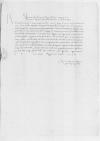Letter #2133
Sigismund I Jagiellon to Ioannes DANTISCUSCracow, 1539-04-13
| received [1539]-04-26 Manuscript sources:
Auxiliary sources:
| ||||||||||
Text & apparatus & commentaryPlain textText & commentaryText & apparatus
Reverendo in Christo Patri, domino
Reverende in Christo Pater, sincere nobis dilecte.
Cum et
Dat(um) or Dat(ae)⌈Dat(um)Dat(um) or Dat(ae)⌉
Ad mandatum regiae maiestatis proprium


 BNW, BOZ 953, f. 171v.
BNW, BOZ 953, f. 171v.